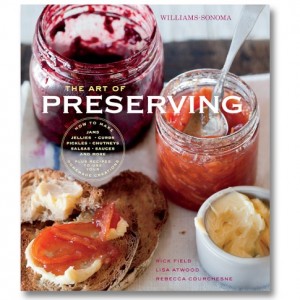A lot of people ask me why we use “conserve” to describe our jams instead of just “jam” or “preserve”. There are a lot of misnomers around what a jam or preserve is. There is what we all think of as jams, preserves, marmalades etc. and there are legal “standards of identity” and as in this case, they do not always coincide. The Food and Drug Administration’s Standards of Identity have been in place since 1940. According to Title 21 of the Code of Federal Regulations Section 150 a “jam or preserve” must have a minimum of 45 to 47 parts fruit ingredient, by weight, be added to each 55 parts, by weight, of sugar or other sweetener. The fruit and sweetener mixture, along with other optional ingredients, must be concentrated to achieve 65% soluble solids (brix). Our conserves only have about 20% added sugar and usually brix in 45-46 range and we wanted to keep it that way. So, this left us with only one option; call it a “spread”. We didn’t really like the name “spread”, we felt it was unappealing. So, a friend suggested that we call it a “conserve”, because of the large chunks of fruit it was more like a conserve than a jam or preserve anyway. In order to be compliant with the FDA’ s labeling laws and standard of identity, we still needed to have the word “spread” on the label so, as small as we could we put “a spreadable fruit” underneath the products name. This may be more euphonious but not very accurate; our conserves are so chunky that most of them are anything but spreadable. Still, we must comply with the FDA’s archaic laws where it comes to food. Conserve is a little confusing as well. For those that do know what a conserve is, and there aren’t many, they usually associate it with a mixture of fruits and often dried fruit and nuts, not unlike chutney but without the acid (vinegar). There is no actual “standard of identity” for a conserve; its definition has been molded by canning history and traditions. Definitions may vary from country to country and region to region. The following is an excerpt from the “Art of Preserving” a book that I co-authored listing the names with commonly accepted descriptions. .
Jams: Chopped or crushed/mashed fruit cooked with sugar until desired jell point or set. Set varies depending on personal preference and pectin content of fruit. A “Jam” may or may not have added pectin. Generally used for accompaniment to breakfast pastries or breads but can also be used for savory sauces. The best jams with the best set are ones made with medium to high natural pectin.
Preserve: Whole or whole pieces of cooked fruit suspended in a soft jelly or syrup. May include spices, wine or spirits and can be used for both savory and sweet dishes. The fruits that lend themselves best to preserves are ones that have little natural pectin or are best preserved whole due to time consuming processing, pitting cherries etc.
Jelly: Clear gelled fruit juice with added sugar and acid if needed. a perfect jelly should be clear not cloudy, jiggle when touched but not be hard or rubbery. Sometimes leaves or flowers can be added to jellies for appearances but by definition jellies do not have any pieces of fruit in them.
Marmalade: Chopped, pureed or sliced citrus cooked with sugar. Ideally, marmalade should have the right ratio of soft jelly from the juice to soft pieces of cooked peel suspended in it. The Marmalade can have one or be a combination of different citrus.
Conserve: Usually a combination of 2 or more fruits, often with dried fruit and nuts, cooked with sugar. Conserves are usually have chunky texture and are served often with cheeses and meats.
Butter: Pureed fruit cooked slowly with little sugar until all liquid evaporated and mixture becomes dark,
Were it not for the sugar requirement we would call our conserves “jam “.When we first started making jam, we tasted everything on the market. Most commercial jams are ridiculously sweet. I believe this is because they are using fruit that has no flavor and sugar is after all, the best preservative; these jars last a lifetime in the refrigerator. Ours however, do not have the longevity that those jams enjoy because of the reduced sugar. This is why we went from a 12oz jar originally to our current 7.75 oz jar; we hope that you will finish it before spoilage is an issue and, this is usually the case. How quickly it begins to show signs of spoilage depends on your refrigerator and where it placed in it, the colder, the better.
But, whatever you call it we have tried to make it as full of fruit flavor and as low in sugar as we could without compromising it’s shelf life. It’s all about the fruit and we’re using the best fruit there is.

 Follow
Follow

